- The importance of intangible cultural heritage is not the cultural manifestation itself but rather the wealth of knowledge and skills that is transmitted through it from one generation to the next.
- The social and economic value of this transmission of knowledge is relevant for both minority and mainstream social groups within a State, and is as important for developing States as for developed one.
UNESCO’s Intangible Cultural Heritage
- The Intangible cultural Heritage according to UNESCO:
- Traditional, Contemporary and Living at the Same Time: intangible cultural heritage does not only represent inherited traditions from the past but also contemporary rural and urban practices in which diverse cultural groups take part;
- Inclusive: They have been passed from one generation to another, have evolved in response to their environments and they contribute to giving us a sense of identity and continuity, providing a link from our past, through the present, and into our future. Intangible cultural heritage does not give rise to questions of whether or not certain practices are specific to a culture. It contributes to social cohesion, encouraging a sense of identity and responsibility which helps individuals to feel part of one or different communities and to feel part of society at large;
- Representative: intangible cultural heritage is not merely valued as a cultural good, on a comparative basis, for its exclusivity or its exceptional value. It thrives on its basis in communities and depends on those whose knowledge of traditions, skills and customs are passed on to the rest of the community, from generation to generation, or to other communities;
- Community-based: intangible cultural heritage can only be heritage when it is recognized as such by the communities, groups or individuals that create, maintain and transmit it – without their recognition, nobody else can decide for them that a given expression or practice is their heritage
- As of 2010 the programme has compiled two lists:
- The longer Representative List of the Intangible Cultural Heritage of Humanity comprises cultural “practices and expressions that help demonstrate the diversity of this heritage and raise awareness about its importance.”
- The shorter List of Intangible Cultural Heritage in Need of Urgent Safeguarding is composed of those cultural elements that concerned communities and countries consider require urgent measures to keep them alive.
UNESCO’s Convention for Safeguarding the Intangible Heritage
- The Convention of the Safeguarding of the Intangible Cultural Heritage was adopted by the United Nations Educational, Scientific and Cultural Organization (UNESCO) in 2003 and entered into force in 2006.
- It comprises 24 members and is elected in the General Assembly of the Convention according to the principles of equitable geographical representation and rotation.
- Members of the Committee are elected for a term of four years.
- Purpose:
- To safeguard the expressions of intangible cultural heritage that are endangered by the processes of globalization.
- To ensure respect for the intangible cultural heritage of the communities, groups and individuals.
- To raise awareness at the local, national and international levels of the importance of intangible cultural heritage.
- Publications:
- Representative List of the Intangible Cultural Heritage of Humanity.
- List of Intangible Cultural Heritage in Need of Urgent Safeguarding.
- Register of good safeguarding practices.
- India will be a member of two UNESCO Committees: Intangible Cultural Heritage (2022-2026) and World Heritage (2021-2025).
- India has served on the ICH Committee twice, from 2006 to 2010 and again from 2014 to 2018.
- The Ministry of Culture has appointed the Sangeet Natak Akademi, an autonomous organization under the Ministry of Culture, as the nodal office for matters relating to the intangible cultural heritage including for the preparation of the nomination dossiers for the Representative List of UNESCO.
- The Sangeet Natak Akademi (SNA) makes it necessary for the stakeholders, experts/officials, etc. prior to the finalization of the dossier in respect of elements identified for the nomination.
- Being the nodal office the SNA maintains a National Inventory of ICH elements and the inclusion of the identified element for UNESCO in the National Inventory/Register etc. of the applicant member state is also a pre-requisite for inclusion in the UNESCO’s Representative List of ICH.
- The Ministry of Culture makes regular Schemes, as well as organizations, make efforts toward the preservation, protection, and promotion of intangible cultural heritage in the country.
- Various autonomous bodies under the Ministry of Culture have comprehensive mandates in this regard and are functioning in various spheres of preservation and promotion of intangible cultural heritage and diverse traditions of the country.
- Some of the major organizations involved in the preservation of propagation of ICH are named below:
- Sahitya Akademi, Lalit Kala Akademi, Sangeet Natak Akademi
- Indira Gandhi National Centre for the Arts
- National School of Drama
- Centre for Cultural Resources & Training
- Zonal Cultural Centres (seven in number)
- Indira Gandhi Rashtriya Manav Sangrahalaya
- AnthrseveralSurvey of India
- Apart from these, there are a number of schemes under the implementation of the Ministry of Culture for providing financial assistance to artists & institutions involved in the promotion/propagation of the various forms of ICH.
- In addition, the Ministry of Culture implements, since the year 2013-14 also, a scheme titled “Scheme for Safeguarding the Intangible Cultural Heritage and Diverse Cultural Traditions of India” with the aims and objectives of professionally enhancing awareness and interest in ICH, safeguarding, promoting, and propagating it systematically.
- India has 15 intangible cultural heritage elements on the UNESCO Representative List.
List of UNESCO Intangible Cultural Heritages in India
- India, known for its heritage and cultural diversity, has 15 cultural heritages in UNESCO’s intangible cultural heritage list. The latest 15th cultural heritage included in the list is Garba, a tradition dance form from Gujarat).
- The inclusion of new heritage elements in UNESCO’s lists of intangible cultural heritage is determined by the Intergovernmental Committee for the Safeguarding of Intangible Cultural Heritage established by the convention.
- In India, Ministry of Culture is charged with preservation, promotion and dissemination of culture of India.
- India was added to the list for the first time in 2008 (at that time total three examples were added).
- In India, Ministry of Culture is charged with preservation, promotion and dissemination of culture of India.
- Nowruz or Navroz is the only object in the list which is shared by twelve countries. Navroz in India is celebrated mainly by Parsi community (Indian Zoroastrianian community).
| Item | Inscribed in Year |
|---|---|
| Kutiyattam, Sanskrit Theatre | 2008 |
| The Tradition of Vedic Chanting | 2008 |
| Ramlila – the Traditional Performance of the Ramayana | 2008 |
| Ramman: religious festival and ritual theatre of the Garhwal Himalayas, India | 2009 |
| Chhau dance | 2010 |
| Kalbelia folk songs and dances of Rajasthan | 2010 |
| Mudiyettu, ritual theatre and dance drama of Kerala | 2010 |
| Buddhist Chanting of Ladakh: recitation of sacred Buddhist texts in the trans-Himalayan Ladakh region | 2012 |
| Sankirtana, ritual singing, drumming and dancing of Manipur | 2013 |
| Traditional brass and copper craft of utensil making among the Thatheras of Jandiala Guru Punjab, India | 2014 |
| Yoga | 2016 |
| Nawrouz | 2016 |
| Kumbh Mela | 2017 |
| Durga Puja in Kolkata, West Bengal | 2021 |
| Garba of Gujarat | 2023 |
Kutiyattam (Sanskrit theatre)
- It was inscribed on the Representative List of the Intangible Cultural Heritage of Humanity in 2008.
- It is one of India’s oldest living theatrical traditions. It originated more than 2,000 years ago in Kerala.
- It represents a synthesis of Sanskrit classicism. It is recognized as an oral heritage and reflects the local traditions of Kerala.
- Kutiyattam is traditionally performed in theatres called Kuttampalams, which are located in Hindu temples.
- Neta abhinaya (eye expression) and hasta abhinaya (the language of gestures) are prominent among its codified theatrical language.
- The main focus of the theatre lies on the thoughts and feelings of the main character. The actor’s art mainly lies in detailed elaboration of a situation or episode with sophisticated breathing control and subtle muscle shifts of the face and body.
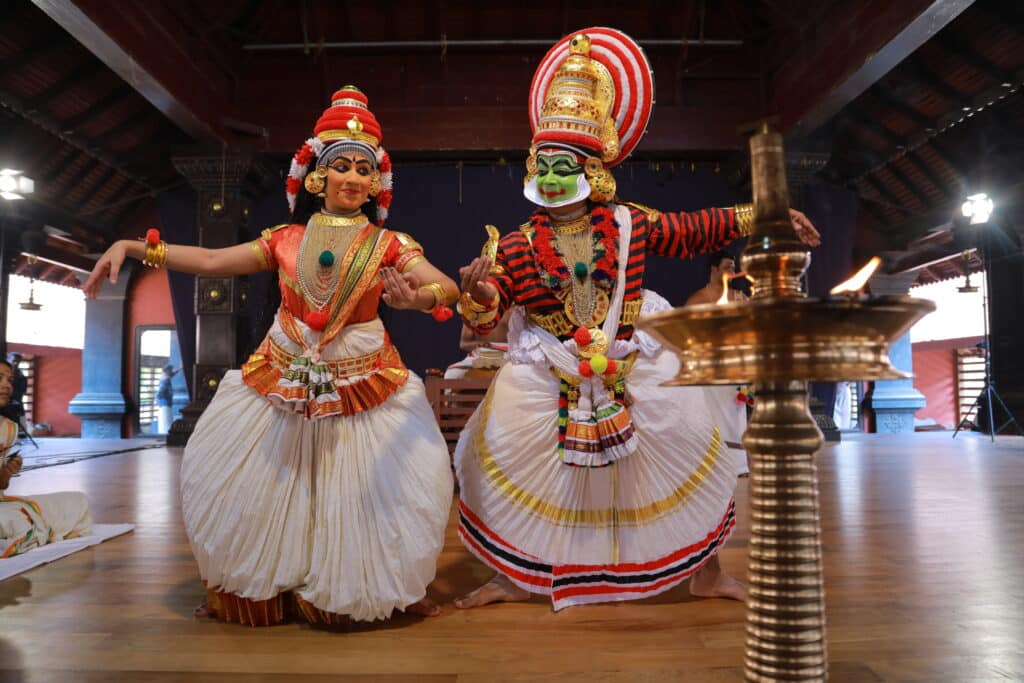
The Tradition of Vedic Chanting
- The Vedas are considered as one of the world’s oldest surviving cultural traditions which have been transmitted orally.
- Verses of Vedas are expressed in the Vedic language (derived from classical Sanskrit) and were chanted traditionally at the time of sacred rituals and recited daily in Vedic communities.
- The importance of this tradition lies not only in the rich content of its oral literature but also from the ingenious methods employed by the Brahmin priests to preserve the texts intact over thousands of years.
- The practitioners were taught from the childhood. Complex recitation techniques based on tonal accents, unique ways of pronouncing each letter and specific speech combinations are taught by the priests to ensure the sound of each word remains unaltered.
- The Vedas also provide necessary insights into the history of Hinduism and development of various artistic, scientific and philosophical concepts like the concept of zero.
- The Rig Vada is a collection of sacred hymns; the Sama Vada includes musical arrangements of hymns from the sources like Rig Vada; the Yajur Vada features prayers and sacrificial formulae used by priests; the Atharva Veda is a collection of incantations and spells.
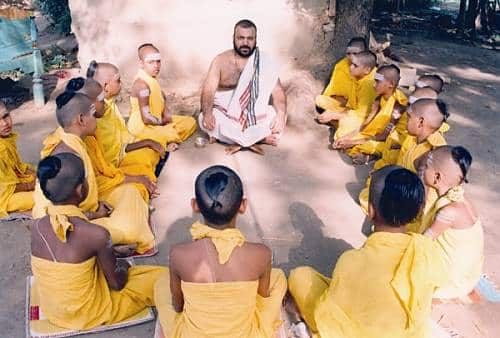
Ramlila – the Traditional Performance of the Ramayana
- It is a performance of then Ramayana epic in a series of scenes that include song, narration, recital and dialogue.
- Performed across northern India during the festival of Dussehra, held each year according to the ritual calendar in autumn.
- The majority of the Ramlilas recount episodes from the Ramacharitmanas through a series of performances lasting ten to twelve days, but some, such as Ramnagar’s, may last an entire month.
- Ramlila recalls the battle between Rama and Ravana and consists of a series of dialogues between gods, sages and the faithful. Ramlila’s dramatic force stems from the succession of icons representing the climax of each scene.
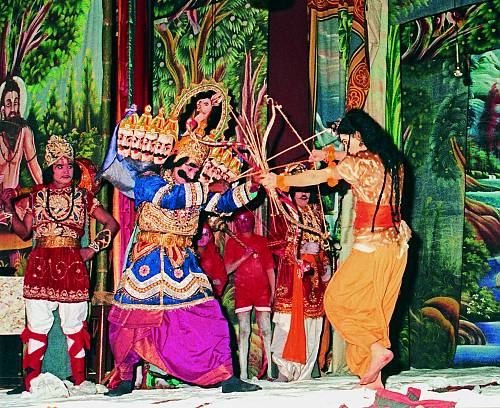
Novruz
- Marks the New Year and the beginning of spring across a vast geographical area covering , inter alia, Azerbaijan, India, Iran, Kyrgyzstan, Pakistan, Turkey and Uzbekistan
- It is celebrated on 21 March every year, a date originally determined by astronomical calculations.
- Novruz is associated with various local traditions, such as the evocation of Jamshid, a mythological king of Iran, and numerous tales and legends.
- Novruz promotes the values of peace and solidarity between generations and within families, as well as reconciliation and neighbourliness, thus contributing to cultural diversity and friendship among peoples and various communities.
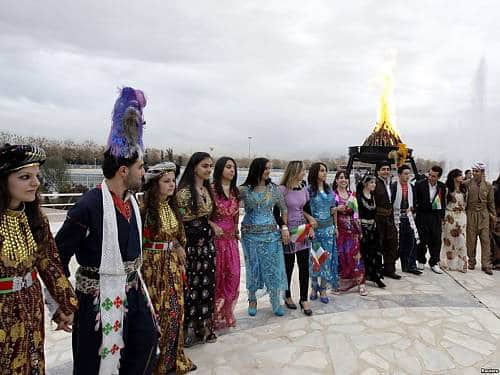
Ramman
- Religious festival and ritual theatre of the Garhwal Himalayas.
- Ramman is a religious festival conducted annually in late April in the twin villages of Saloor-Dungra (Uttarakhand) in honour of the tutelary god, Bhumiyal Devta, a local divinity.
- Ramman is a multiform cultural event which combines theatre, music, traditional oral and written tales.
- The event contributes in reflecting environmental, spiritual and cultural concepts of the community and also helps in strengthening its sense of self-worth.
- The festival comprises of highly complex rituals such as the recitation of a version of the epic of Rama and various legends, performance of songs and masked dances.
- The festival is organized by villagers and the family that hosts Bhumiyal Devta during the year follows a strict daily routine. Each caste and occupational group is earmarked to play a distinct role.
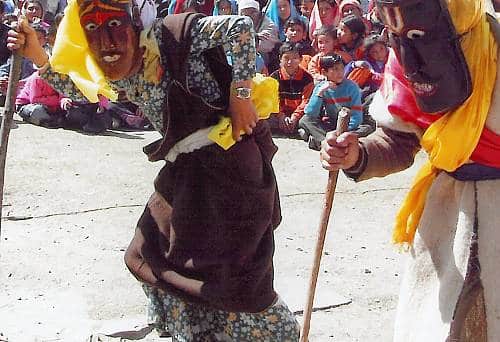
Chhau Dance
- Tradition from eastern India that enacts episodes from epics including the Mahabharata and Ramayana, local folklore and abstract themes.
- Its three distinct styles hail from the regions of:
- Seraikella, Purulia and Mayurbhanj.
- Chhau dance is intimately connected to regional festivals, notably the spring festival Chaitra Parva.
- Its origin is traceable to indigenous forms of dance and martial practices.
- Its vocabulary of movement includes mock combat techniques, stylized gaits of birds and animals and movements modelled on the chores of village housewives.
- Chhau is taught to male dancers from families of traditional artists or from local communities.
- The dance is performed at night in an open space to traditional and folk melodies, played on the reed pipes mohuri and shehnai. The reverberating drumbeats of a variety of drums dominate the accompanying music ensemble.
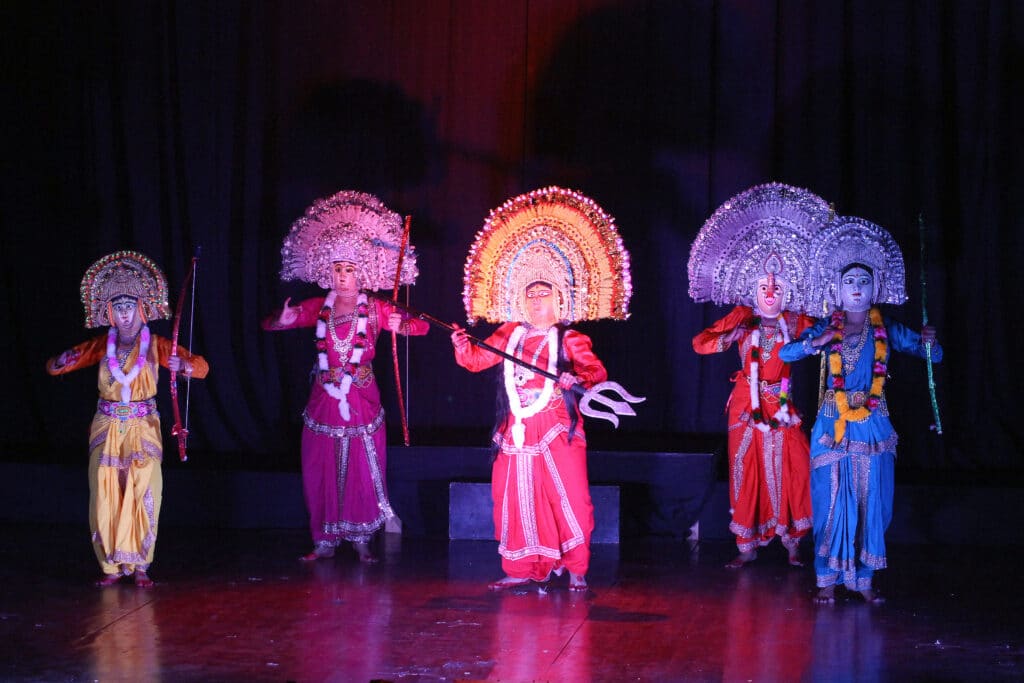
Kalbelia folk songs and dances of Rajasthan
- Kalbelias are traditional snake catchers.
- Songs and dances are a matter of pride and portray the traditional way of life of the Kalbelia community.
- Kalbelia songs disseminate mythological knowledge through stories. The songs are also the testimonials to the poetic acumen of the Kalbelia, who are known to compose lyrics spontaneously during performances.
- The songs and dances were transmitted from generation to generation and form a part of an oral tradition without any training manuals or texts.
- Women performers wear flowing black skirts to replicate the movements of a serpent by dancing and swirling and the men accompany them plays different instruments such as ’’khanjari”, a percussion instrument and the ’’poongi,” a woodwind instrument traditionally played to capture snakes.
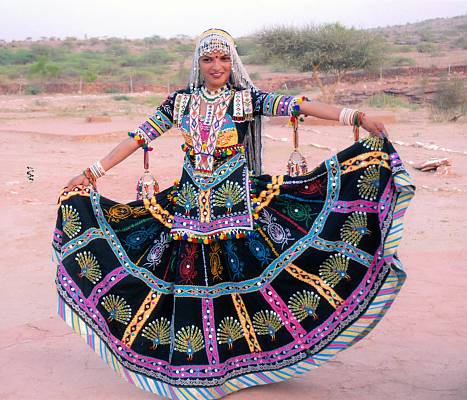
Mudiyettu
- Ritual theatre and dance drama of Kerala.
- Mudiyettu is a ritual dance based on the mythological tale of a battle between the goddess Kali and the demon Darika.
- Mudiyettu is a community ritual which entails the participation of entire village and performed every year in ‘Bhagavati Kavus’, the temples of the goddess, in the villages along the rivers Chalakkudy Puzha Periyar and Moovattupuzha.
- It is organized after the harvest of summer crops. Mudiyettu performers after purifying themselves through fasting and prayer draws a huge image of goddess Kali, called as “kalam”, on the temple floor using coloured powders and the spirit of the goddess is invoked.
- Mudiyettu serves as an important cultural event for strengthening mutual cooperation and collective participation and transmission of traditional values, ethics, moral codes and aesthetic norms of the community to the next generation.
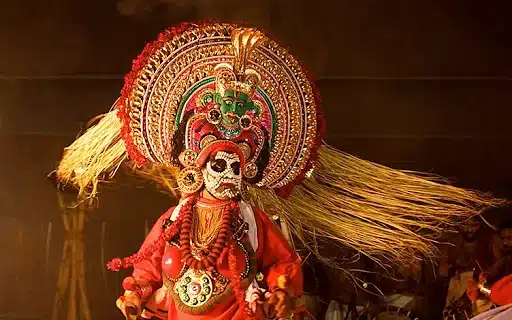
Buddhist Chanting of Ladakh
- Sacred texts representing the spirit, philosophy and teachings of the Buddha are recited by the Buddhist lamas in various monasteries and villages of the Ladakh region.
- The recitation of sacred texts are done for the spiritual and moral well-being, purification and peace of mind, appeasement of evil spirits or for invoking the blessing of various Buddhas, Bodhisattvas, deities etc.
- The chanting is also done in the monastic assembly hall as a prayer to the deities for world peace, and for the personal growth of the practitioners.
- The chanting is performed in groups and the monks wear special costumes and make mudras (hand gestures) representing the divine Buddha. Various instruments such as bells, drums, cymbals and trumpets are played to lend musical rhythm to the chanting.
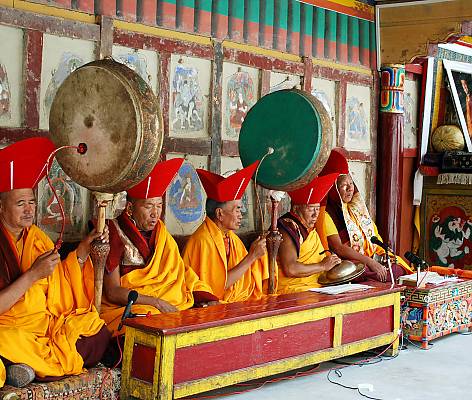
Sankirtana of Manipur
- It encompasses an array of arts performed to mark religious occasions and various stages in the life of the Vaishnava people of the Manipur plains.
- Sankirtana practices centre on the temple, where performers narrate the lives and deeds of Krishna through song and dance.
- Sankirtana has two main social functions:
- it brings people together on festive occasions throughout the year, acting as a cohesive force within Manipur’s Vaishnava community:
- and it establishes and reinforces relationships between the individual and the community through life-cycle ceremonies.
- Regarded as the visible manifestation of God.
- Sankirtana works in harmony with the natural world, whose presence is acknowledged through its many rituals.

Brass and Copper Utensil (Thatheras)
- Traditional brass and copper craft of utensil making among the Thatheras of Punjab
- It is traditional technique of manufacturing brass and copper utensils in Punjab.
- The metals used – copper, brass and certain alloys – are believed to be beneficial for health.
- The process of manufacturing is transmitted orally from father to son.
- Metalwork is not simply a form of livelihood for Thatheras, but it defines their family and kinship structure, work ethic and status within the social hierarchy of the town.
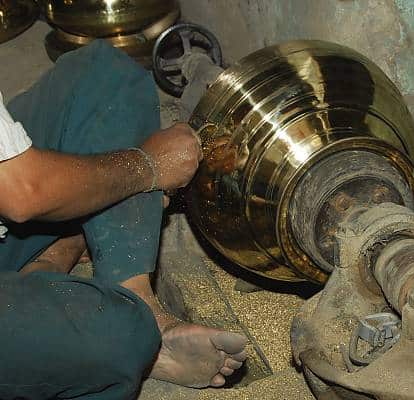
Yoga
- The philosophy behind the ancient Indian practice of yoga has influenced various aspects of how society in India functions, whether it be in relation to areas such as health and medicine or education and the arts.
- Yoga consists of a series of poses, meditation, controlled breathing, word chanting and other techniques designed to help individuals build self-realization, ease any suffering they may be experiencing and allow for a state of liberation.
- Traditionally, yoga was transmitted using the Guru Shishya model (master-pupil) with yoga gurus as the main custodians of associated knowledge and skills.
- Nowadays, yoga ashrams or hermitages provide enthusiasts with additional opportunities to learn about the traditional practice, as well as schools, universities, community centres and social media.

Kumbh Mela
- Kumbh Mela (the festival of the sacred Pitcher) is the largest peaceful congregation of pilgrims on earth, during which participants bathe or take a dip in a sacred river.
- Devotees believe that by bathing in the Ganges one is freed from sins liberating her/him from the cycle of birth and death.
- Millions of people reach the place without any invitation. The congregation includes ascetics, saints, sadhus, aspirants-kalpavasis and visitors.
- The festival is held at Allahabad, Haridwar, Ujjain and Nasik every four years by rotation and is attended by millions of people irrespective of caste, creed or gender.
- Its primary bearers, however, belong to akhadas and ashrams, religious organizations, or are individuals living on alms.
- Kumbh Mela plays a central spiritual role in the country, exerting a mesmeric influence on ordinary Indians.
- The event encapsulates the science of astronomy, astrology, spirituality, ritualistic traditions, and social and cultural customs and practices, making it extremely rich in knowledge.
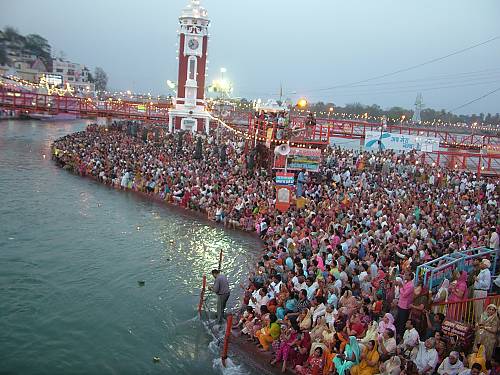
Durga Puja
- Durga Puja is an annual event held in September or October in Kolkata, West Bengal, India, but also in other regions of India and among Bengali diaspora living abroad.
- It commemorates the Hindu mother-goddess Durga’s ten-day adoration.
- Small artisanal workshops make representations of Durga and her family using unfired clay taken from the Ganga River in the months leading up to the festival.
- On the first day of Mahalaya, eyes are painted onto clay figurines to bring the goddess to life, and devotion of the goddess starts.
- On the tenth day, the idols are immersed in the river from where the clay was obtained.
- As a result, the celebration has come to symbolize ‘coming home’ or a seasonal return to one’s roots.
- Durga Puja is regarded as the greatest example of public religious and artistic performance, as well as a fertile field for collaboration artists and designers.
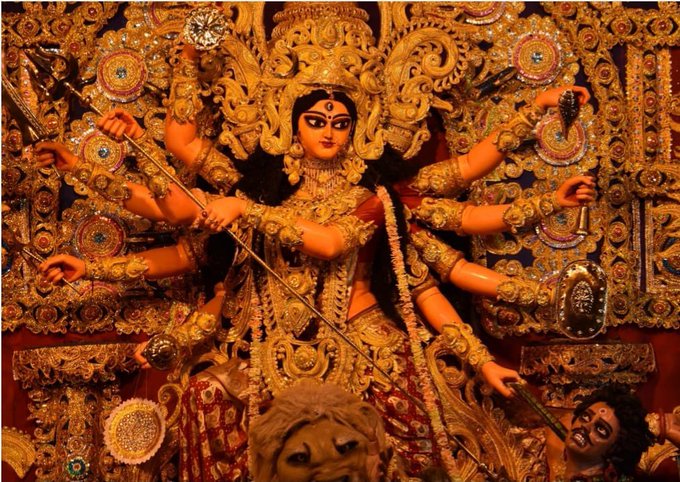
Garba of Gujarat
- Garba is a form of Gujarati dance which originates from the state of Gujarat. The name is derived from the Sanskrit term Garbha.
- Many traditional garbas are performed around a centrally lit lamp or a picture or statue of the Hindu goddess Durga.
- Traditionally, it is performed during the nine-day Hindu festival Navaratri.
- Either the lamp (the Garba Deep) or an image of the Goddess, Durga (also called Amba) is placed in the middle of concentric rings as an object of veneration.
- Garba is performed in a circle as a symbol of the Hindu view of time. The rings of dancers revolve in cycles, as time in Hinduism is cyclical. As the cycle of time revolves, from birth, to life, to death and again to rebirth, the only thing that is constant is the Goddess, that one unmoving symbol in the midst of all of this unending and infinite movement.
- Modern Garba is also heavily influenced by Dandiya Raas, a dance traditionally performed by men. The merger of these two dances has formed the high-energy dance that is seen today.
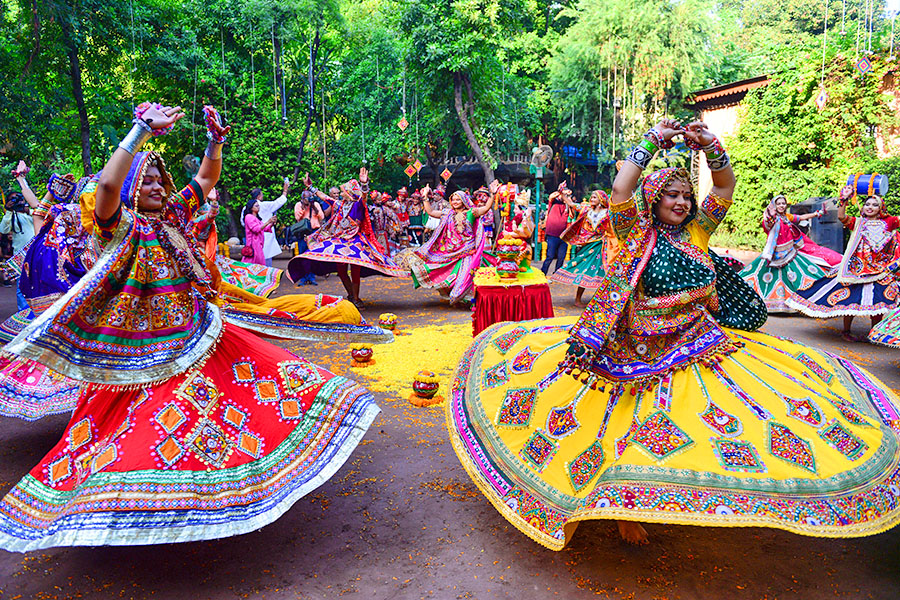

thanks a lot to the whole team for your efforts
Most Welcome, Keep Reading.